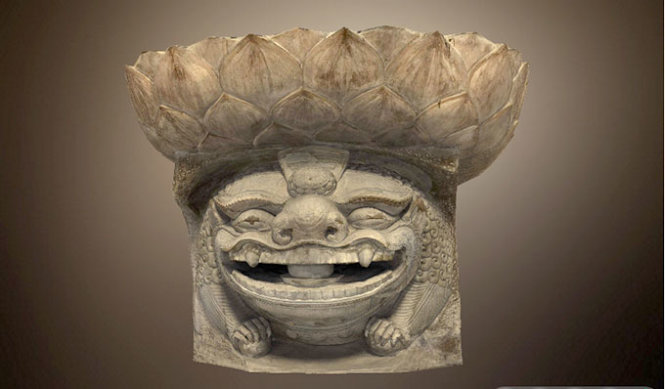A 17-year-old boy has quit school to dedicate all his time to promoting sculptures, particularly Vietnamese mascots, by creating 3D scans of hundreds of them.
>> An audio version of the story is available here
Nguyen Tri Quang, who resides in Hanoi, has successfully put hundreds of 3D-scanned objects on his website, Vr3d.vn.
Born to a family of craftspeople, since he was a little boy Quang has followed his father to relics across the country and gathered myriad samples.
In August last year, the Ministry of Culture, Sports, and Tourism issued a document warning against the use of exotic mascots, particularly Chinese-style stone lions, in religious institutions and public agencies.
The warning came as a devastating blow to stone carving villages throughout the country, particularly in Da Nang in the central region and Ninh Binh Province in the north, as few customers are willing to buy new Chinese-style mascots, and existing statues are being moved out of pagodas, temples and public agencies.
As many stone mascot carving businesses have ground to a halt, owners and craftspeople across the country are struggling hard to find a way out.
Many are also at a loss in telling Vietnamese mascots from foreign ones.

A 3D scan of a pair of Vietnamese stone lions as seen on Nguyen Tri Quang's website. Photo: vr3d.vn
The online library of Vietnamese mascots
During Vietnam's first exhibit on purely traditional Vietnamese mascots, which took place in Hanoi in mid-November last year, Quang instantly thought of how to promote the purely Vietnamese mascots based on his father’s, and his own, collections over almost 10 years.
“In my opinion, such exhibits are spatially and chronologically limited, as many can’t make it to the exhibit. I then thought of launching our collections in the form of 3D on our website, and make them readily accessible to everyone,” the young man explained.
The website of his family’s business, which he launched and runs himself, features a section of digitized Vietnamese mascots.
Unlike conventional 3D technology, in which the performer reconstructs an item from observing it, the VR3D scanning technique which Quang has adopted uses a 3D scanner to vividly capture the items in three dimensions and depict all of their angles and decorative patterns.
It takes the young man around five days to finish a 3D scan for a simple mascot and post it on his website.
Larger objects with richer details pose a greater technical challenge and take more time.

A 3D scan of a wooden "nghe" (stylized dog) statue, which also serves as a light base, as seen on Nguyen Tri Quang's website at www.vr3d.vn
“The colors and sizes of the objects posted on my website are perfectly authentic and precise. Specks of dust and patches of moss on the real-life mascots can even be spotted on my 3D-scanned objects. Those interested, particularly artisans, can rotate and interact with them with great ease,” the teenager explained.
He noted that Ba Tam Pagoda’s lion statue, which is displayed at the Vietnam Fine Arts Museum, is only a version of the original, currently kept at the pagoda in Hanoi.
Meanwhile, his 3D-scanned copy is exactly that of the original.
After 3D-scanning the objects, Quang optimizes the scanned copies and adds them to his website.
His “online Vietnamese mascot library” currently boasts hundreds of mascots and offers viewers an insightful, comprehensive window on the country’s sacred sculptures, which span various historical periods and adopt a wide array of styles.
Quang’s father showed him the 3D-scanning technique years ago, but he taught himself how to post them on his website.
Quitting school
He launched his family business’s current website in eighth grade.
Infatuated with the 3D-scanning technology, after finishing the grade, the boy insisted his parents allow him to quit school and devote all his time to his passion.
Though his parents initially objected vehemently to their son’s intention to quit school, they finally gave in to him and allowed the man to drop out one year later after he proved he was right.
His mother now says that they have not regretted the decision.
Dream of digitizing heritage sites nationwide
Quang is particularly intrigued by the multiple applications of the 3D-scanning technology, including e-commerce and preserving heritage samples.
His “library” now also boasts quite a large number of antique sculptures.

A 3D scan of a "nghe" (stylized dog) statue, which is currently placed at the Hue Royal Palace in central Vietnam's Thua Thien-Hue Province, as seen on Nguyen Tri Quang's website at www.vr3d.vn.
The young man said his dream of tapping into the VR3D technology’s numerous strengths to digitize all the heritage sites across the country so that he can help preserve and promote them to the world.
“The technology can also give us access to the national treasures which are owned by individuals or organizations in other countries,” Quang said.
He also plans to integrate a measurement tool into the mascots’ details, so that artisans can work out corresponding dimensions in crafting sculptures based on the copies which are available on his website.
Revered researcher Tran Hau Yen The, who serves as Quang’s consultant in providing annotations for his copies of Vietnamese mascots, highly regards the young man’s efforts and ambitions.
“Quang’s innovative 3D scanning process is one of the best ways to help revive and promote Vietnamese mascots. His copies give local artisans immensely helpful clues on how to craft purely Vietnamese mascots,” The observed.
Vi Kien Thanh, head of the Department of Arts, Photography and Exhibition under the Ministry of Culture, Sports, and Tourism, said his department will invite more experts to help Quang with annotations on his copies.

Nguyen Tri Quang, 17, is pictured in his neighborhood in Hanoi. Photo: Tuoi Tre
Like us on Facebook or follow us on Twitter to get the latest news about Vietnam!


















































